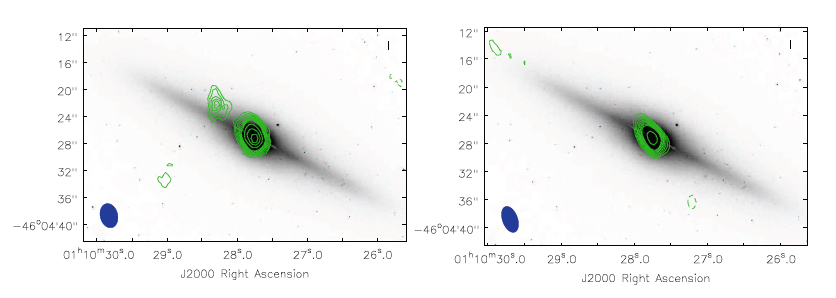Discovery of a transient radio jet from an intermediate-mass black hole
Sporadic ejections of matter are observed in the form of radio jets from supermassive black holes in active galaxies as well as from galactic binary systems hosting a black hole of several solar masses. Do these observations indicate that jet formation is a universal property of black holes, regardless of their mass? The detection, for the first time, a transient radio jet from an intermediate-mass black hole by an international collaboration led by two French teams (IRAP in Toulouse and Service d'Astrophysique-Laboratoire AIM from CEA-Irfu at Saclay) finally settles the debate. The observations of the source HLX-1, using the ATCA radio telescope in Australia, have also helped to constrain the black hole mass to be between 9000 and 90,000 solar masses. This result, published in Science Express on 2012 July 5, provides a bridge between the two extremes of the population of black holes.

Increased X-ray activity and relativistic plasma ejection
The first phases of the plasma ejection at relativistic speeds in black hole systems are marked by a resurgence of activity in high-energy. After this first high-energy signal it is possible to observe episodes of mass ejection at relativistic speeds. These are detected in the form of transient radio jet in galactic binary systems containing a black hole of several solar masses. But is this scenario also applies for intermediate-mass black holes? Scientists were interested in the source HLX-1, because it is the best candidate so far to harbour an intermediate-mass black hole. HLX-1 is located in the galaxy ESO 243-49, a galaxy at 300 million light years away.
The resurgent activity was triggered twice (in September 2010 and August 2011) by the NASA Swift satellite, which manifested in an X-ray state change of HLX-1. This alarm allowed scientists to examine its behaviour in the radio with the ATCA telescope in Australia. Indeed, a transient radio source appears in the data during this active episode at the position of the X-ray source. The similar behaviour between HLX-1 and stellar black holes is striking. We are thus witnessing the ejection of matter at very high speed around a black hole, that is much more massive than its galactic cousins. These observations were also used to constrain the black hole mass of HLX-1, placing it in a range between 9000 and 90,000 solar masses.

Proof of black hole unification
The transient radio jet in the source HLX-1, similar to those seen in active galaxies hosting a supermassive black hole (millions or billions of solar masses) or in galactic X-ray binaries systems like microquasars (where the black hole is a few solar masses) confirms the common physical process in these objects.
Mass ejections at relativistic speed observed in the form of radio jets seem to be consistent and provide an overview of the physics around black holes. This scenario, however, must be weighted by the current low number of observational evidence of intermediate-mass black holes, objects in the main focus of research.
Contacts (CEA) : David Cseh, Stéphane Corbel
Publication :
“Radio Detections During Two State Transitions of the Intermediate Mass Black Hole HLX-1”
Natalie Webb, David Cseh, Emil Lenc, Olivier Godet, Didier Barret, Stephane Corbel, Sean Farrell, Robert Fender, Neil Gehrels, Ian Heywood
published in Sciences express, 2012 July 5
Written by: Christian Gouiffès


